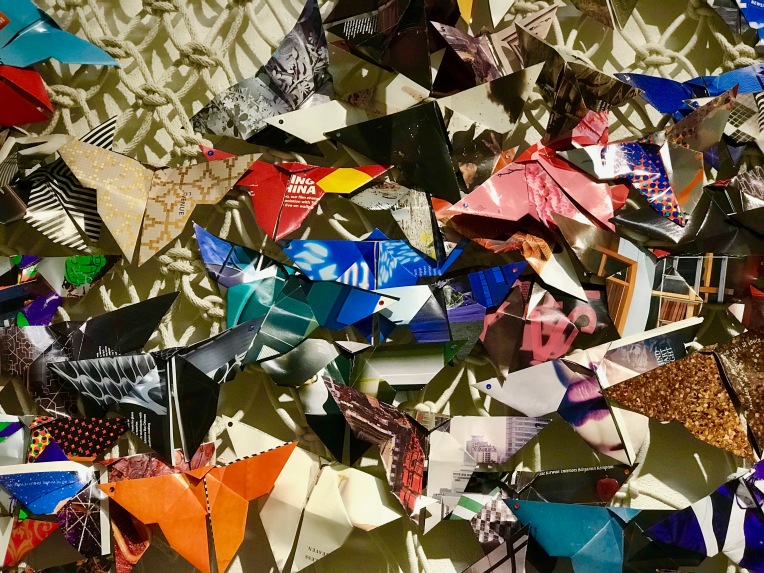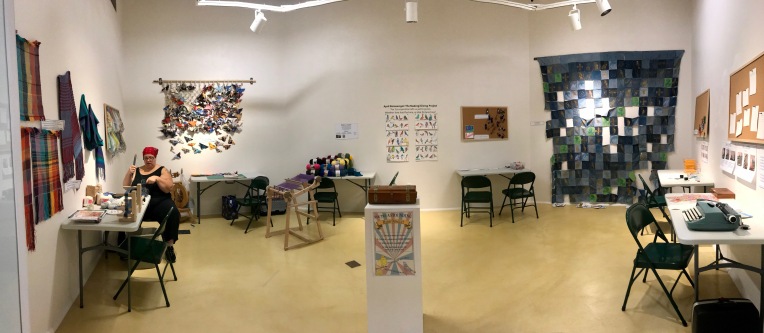
This week I had the opportunity to sit down with artist April Beiswenger and talk to her about her exhibition currently featured in the Godschalx Gallery, April Beiswenger: The Making and Giving Project.
On sabbatical from her regular position as a professor of Theatre Studies here at SNC, Beiswenger spends much of her time in the gallery doing just what she asks visitors to do: making and giving. The exhibition offers many opportunities for visitors to create and engage including: bracelet making, typing letters on a typewriter, coloring postcards, asking the sage advice of the Bird Oracle, and much more.
The following interview explores the philosophy and mission behind Beiswenger’s interactive exhibition, an exhibition that allows viewers—or rather makers—to revel in the simple and inherent satisfaction of creation and the joy that comes from giving a creation away. The overarching message she wants you to get? Don’t be scared of making. Just do it, move on, and then do it again.
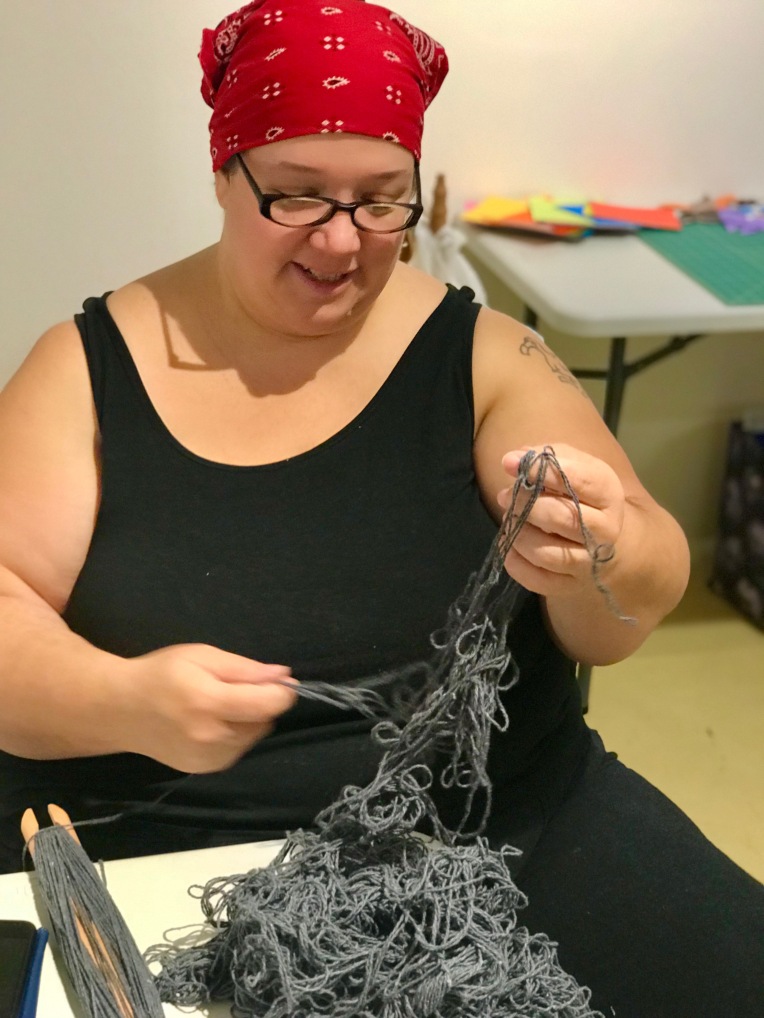
Katie Hopkins: Tell us a little bit about how the Making and Giving Project originated.
April Beiswenger: The idea behind the Making and Giving Project is that there is an art to making, and that’s what we learn as students and as adults. As we become artists we learn the “making,” but sometimes we miss the “giving” part. And so, it happened at my gallery show last year, [April Beiswenger: ‘I like this place, and willingly could waste my time in it.”] whenever I was in the gallery and I was working on that topographical map—gluing the beads down to that—people would come by and talk to me about it, so it sort of sprung from that idea of I’m gonna make things and people are gonna watch me make things.
What am I gonna do with the stuff I make? Well, I’m gonna give it away. Because we get all these skills that we’re not necessarily gonna use, you know, like beading and knitting and crocheting and all of this stuff that it becomes like an impassioned hobby and not necessarily lucrative. But we can’t not make, so what about just giving it away? So that’s kind of where it sprung from, like what if I just gave stuff away?
KH: Do you think that the location of your exhibition here at the SNC Galleries helps with that “giving” aspect of your mission?
AB: I think so. There’s a giving-ness to the St. Norbert College community that has been quite apparent ever since I got here, that idea of radical hospitality, that you don’t necessarily see in other [institutions]. I went to a Catholic school for undergrad, went to a Catholic school for grad school, I worked in another Catholic school when I first started teaching, and now here. There’s always an element of giving when working for Catholics which is interesting, but there’s this element of giving that they had, but they didn’t have ingrained in their mission, this idea of radical hospitality and Communio, which is one of the reasons I love working here so much. [Here] they’re just open hearted and giving and it kinda works really nice, and watching people engage with the elements in this room makes me really happy.
KH: Is there a certain element or activity that visitors seem to like the best so far?
AB: That typewriter! So I bought this typewriter a bunch of years ago whenever we were gonna have a Sandbox over in the library—this maker space—and it never really ended up coming in. So [the typewriter] moved with me when I moved houses and I tripped over it in my workshop at home and I thought “let’s use the typewriter,” why not? There’s an activity to typing that you don’t get with a computer or texting. There is a physical, mechanical-ness that you get using a typewriter that you don’t get anywhere else that’s really visceral. My mom was a secretary for ages and ages, but when my sister and I were kids, she had this typewriter that she was like, please shut up, use this, and so Gina and I, my next younger sister, we would type for ages with this thing. And then my youngest sister Lisa, and Adam, my brother, we all had an experience with this typewriter. And the typewriter goes with the other mechanical objects in the gallery like the Rigid Heddle Loom and the Inkle Loom and the crocheting, that are mechanical production, hand production that is just so wonderful. There’s a pleasure to it, a pleasure to using your hands.
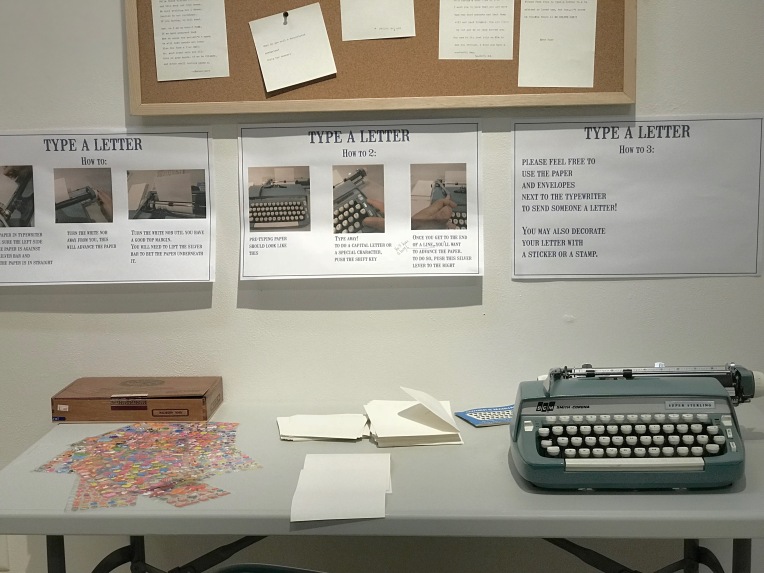
KH: Do you think that the students in particular are drawn to the typewriter because they are so used to just texting on their phones?
AB: I absolutely think so. I think it’s a novelty. And it’s something that is, unlike the looms, where you have to have a little bit of skill to use the looms, the typewriter is just like your laptop and you just clunk clunk clunk clunk clunk and you’re on your way. Hopefully I can do another Making and Giving event, like last week I did silk dying and this week is the Yarn-In*, and so I have two and a half weeks left, and in that time I’ll do a “hey come touch a loom, you’ve never touched one before, come touch a loom!” And people will probably not think anything of it now, but it’ll intrigue them and ten years down the road, twenty years down the road they’ll really enjoy that and say, hey, I’m gonna buy a floor loom and see what happens.
*The Yarn-In is Friday, September 14. It is an all-day event in the Godschalx Gallery. Come and go as you please with your own project, or learn the basics of crocheting from April.
KH: Where can people find out when the Making and Giving Events are happening?
AB: I put them on the SNC news and I send out a classified.
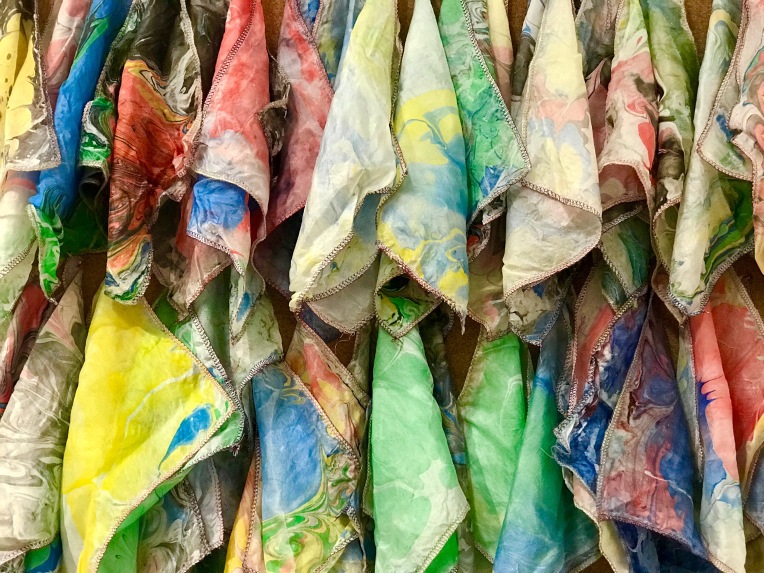
KH: Do you have a favorite making station in here?
AB: The looms. I picked up weaving a couple years ago, and I did beading and it was alright. And then I got into this and started it when I started teaching the History of Clothing and Fashion. I don’t want to give the illusion when I teach this class that these clothes sprung fully formed from a machine. In history there’s actually people making this stuff. When you see Marie Antoinette over and over in these fabulous dresses, she has a woman who runs her dressmaking studio and had the ear of the queen and affected policy. It’s the idea of somebody who makes so well that they can affect policy change. And you know that happens all the time. And so it started there and then I did this great weaving workshop in May up at Sievers School of Fiber Arts in Washington Island. My mom and I went up and weaved pieces which was great because I got to spend time with my mom, and again it’s that mechanical making that is so, so satisfying.
KH: There’s a sense that you really want people to be more well-balanced and that making/mechanical production can help with that.
AB: I think so, I think so. The other one I like a lot, which is less active is the Bird Oracle and I kinda dig that. It’s just come and pull a card and get insight.
KH: I’ve asked the Bird Oracle a few questions and I’ve loved it every time.
AB: Excellent! I have the weirdest words in there. I went online and searched weird words and I got these lists and used them. I don’t know what they mean! I’ve forgotten what they mean. I have them written down in my notebook and every once in a while I have to go what did that word mean…oh yes, that’s what it was!
KH: I believe there’s magic in it, I’d like to think so.
AB: For sure. Especially because I have no clue what they mean.
KH: That’s the beauty of it! You can interpret it however you want.
AB: The magic of a dictionary.
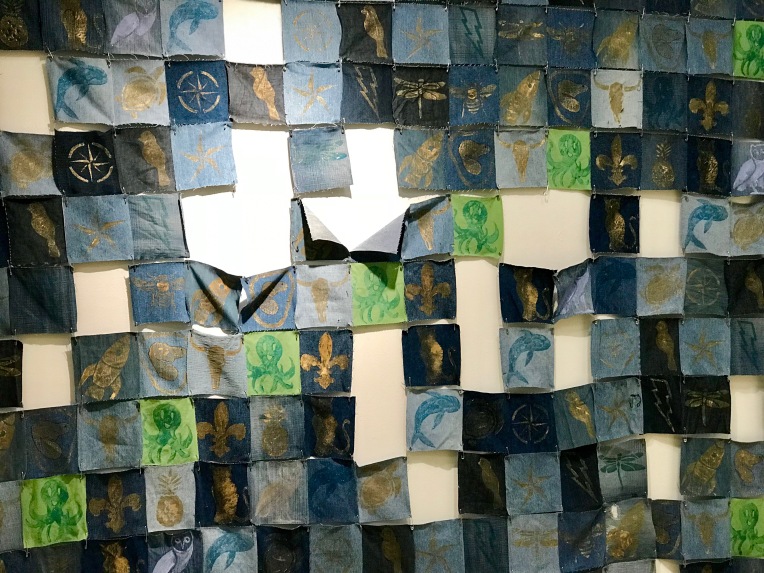
KH: Do you have any future plans to keep this project going?
AB: Yes. This has worked really well. Better that I thought it would. I think the idea of performative making is something I’m going to continue to explore. I do that in my classes. We make stuff together in my design classes and in our lab class for the show. We make together and it’s like connective tissue. It’s the old idea of the quilting bee. You sit around and make together. We used to call it the stitch and bitch. My aunts and family would get together and get into a costume shop and we would all just have our projects and we’d just sit around and complain or gossip. It’s really fun, but it’s kinda stereotypical that you would expect a costumer to know all the good gossip. Which is not true. Carpenters know all the good gossip. So yeah I really like this. I might figure out a way to take it out into Green Bay, maybe with the Boys and Girls club. Maybe with taking it into Art Garage and doing a mini residency. The only reason it works really well right now is because I’m on sabbatical. I was able to take a month out of my sabbatical and spend time in here. During the regular semester there’s no way.
KH: What’s nice is that the concept of making and giving can easily be taken out into the world by anyone. Because of that, this is one of the most approachable exhibitions we’ve had in the galleries especially with visitors being able to physically engage with the art.
AB: And that’s why my next couple [of exhibitions] will probably be very performative.
KH: Those are always a big hit.
AB: I hope so.
End.
Catch the Making and Giving exhibition in the Godschalx Gallery located in Bush Art Center until September 28, 2018. Keep an eye out for those pop-up Making and Giving events and be sure to visit the gallery on SNC day, September 22 for more special activities.
